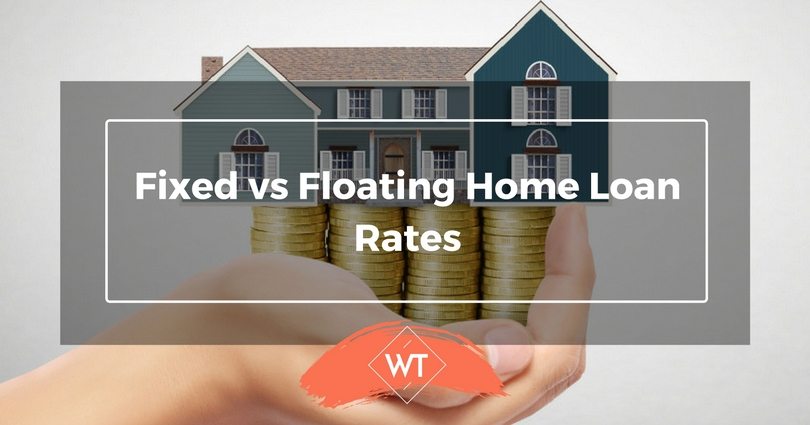Fixed vs Floating Home Loan Rates

Taking a home loan can be a confusing and harrowing experience. Getting a home loan today is easy but understanding the fine print is not; you should do your homework well before you rush into something. Whether to choose a floating or a fixed rate is a dilemma faced by most home loan applicants, so let us try and understand these terms.
Understanding Fixed and Fluctuating Rates:
Fixed rate as the name implies means that the interest rate remains unchanged during the entire duration of the loan. Banks offer fixed rate loans at a premium to cover the cost of inflation over the years so theoretically the EMI (equated monthly installment) will not change over the loan period.
However this does not happen in the real world; the interest rates are usually revised by the bank after a fixed period of time. This period may vary from two to three years depending on the financial institution’s policy, so actually they should be known as semi-fixed rates.
Also if you go through the fine print then the bank has the right to change the rate under various conditions at its discretion.
Floating rates essentially change with the market condition and are adjusted as per the inflation or percentage increase and decrease in the economy.
Floating rates are linked to the bank’s base rate; each bank may choose its own methodology to fix this base rate. These rates have to be declared by the bank each quarter.
Choosing between Floating and Fixed Rates:
Lets compare the home loan rate options and see what suits you best
| Advantages | Disadvantages | |
| Fixed Rate | #1. Stable EMI: Monthly payments will remain consistent with no surprises in the short term. Please read the fine print on the loan offer. Your bank has the right to change the rate under various conditions at its discretion | #1. Higher Interest Rates: Interest rates for fixed interest loans are generally 2% more as compared to the fixed rate loans.#2. Rate can still readjust: It makes sense for fixed income and risk averse applicants to opt for a fixed rate loan but as discussed earlier this does not actually happen. So choosing a fixed rate may not make sense because they do not remain fixed. |
| Floating Rate | #1. Lower Interest Rates: Interest rates for floating interest loans are generally 2% less as compared to the fixed rate loans. So if you opt for a 15 year loan then the floating rate would be let’s say 9.75% while the fixed rate would be around 11.75%.#2. Rates can fall: Another advantage with floating interest rates is that when the markets soften; the banks will have to reduce its lending rates to customers. Though lower interest is not automatic and straightforward, it can still be done | #1. Higher Payments:If interest rates go north (high) significantly, then so will your monthly payments |
Example
Let’s assume you lake a loan of Rs. 20 lakhs for 15 years; Floating loan is available at an interest rate of 9.75% and Fixed loan at an interest rate of 11.75%.
If you opt for the floating interest loan then your EMI (monthly payment) is Rs. 21,187. The EMI for same loan at the fixed rate would be Rs. 23,682. Monthly you end up saving Rs. 2,495 opting for a floating rate home loan. It might not seem like a huge amount – however over the entire loan duration of 15 years, you will save up to Rs. 4,49,100 assuming the rates remain constant.
You will benefit choosing a floating rate home loan as long as the interest rates do not go beyond 11.75%. A significant chunk of home loan takers opt for a floating interest rate. They form a large and powerful group whose demands politicians cannot disregard. If you feel that a sharp increase in the home loan rates is unlikely at least in the short run, then floating rate is the preferred option
Things to Keep in Mind
- Choose a bank which has a transparent way of fixing its rates. Banks like Kotak Mahindra and Axis link their home loan rates to their fixed deposit rates while a few other may link it to MIBOR (Mumbai Inter Bank Offer Rates); both these are fairly transparent ways of doing it.
- A good way of checking whether a bank offers truly floating rates is to go through their base rates during 2002-2003 and see if they actually passed down the benefit of the falling rates to their customers.
- Be a vigilant customer and keep reviewing your decision at least twice a year; you do not have to stick to the decision taken at the inception. You can change it (from floating to fixed and vice versa) keeping in mind the cost involved.
- Teaser Rate Schemes or Special Home Loan schemes are offered by a few banks like SBI. Here the initial rate is fixed for a few years and the after a certain period floating rates will be applicable.
Last but not the least research well, talk to existing loan holders, go through market trends, study historical data, make comparisons between quotes from various banks (compare rates, term and conditions) and if required seek a professional’s help because a home is a huge and a long term commitment.









Leave a Reply